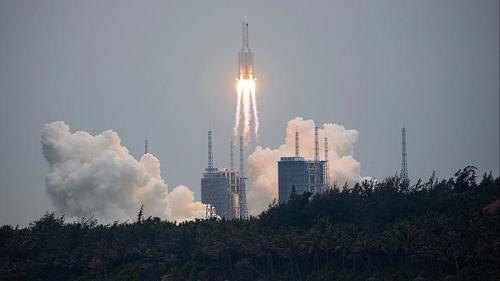
By Tyler Durden
The Pentagon and US Space Command are said to be tracking a large Chinese rocket which is set to reenter Earth’s atmosphere at some point this coming weekend, likely “around May 8th” according to the latest DoD statement. Crucially, the concern is that the falling rocket’s debris could land on inhabited places and pose a danger to people below, given that it is among the largest ever launces to make an uncontrolled and high speed re-entry into earth’s atmosphere.
It’s also the Chinese Long March 5B rocket’s size – at 30 meters in length and weighing 22 tons – that poses the likelihood that an immense amount of debris could fall down to Earth’s surface as opposed to be being burned up upon re-entry, as is typical with smaller rockets.
US Defense Department spokesman Mike Howard issued to following details in a Tuesday statement:
The rocket’s “exact entry point into the Earth’s atmosphere” can’t be pinpointed until within hours of reentry, Howard said, but the 18th Space Control Squadron will provide daily updates on the rocket’s location through the Space Track website. The rocket was used by the Chinese to launch part of their space station last week. While most space debris objects burn up in the atmosphere, the rocket’s size — 22 tons — has prompted concern that large parts could reenter and cause damage if they hit inhabited areas.
This is something which, though very rare, has happened in the recent past. In May of 2020 a Chinese Long March 5B made a similarly uncontrolled re-entry which resulted in debris raining down on inhabited areas of the Ivory Coast.

At one point during that 2020 incident it was feared the debris could fall over the North American mainland, but it had re-entered over the Atlantic with debris reaching the African coast, as photos at the time showing pieces of internal rocket components scattered across a village confirmed…
Reports of a 12-m-long object crashing into the village of Mahounou in Cote d'Ivoire. It's directly on the CZ-5B reentry track, 2100 km downrange from the Space-Track reentry location. Possible that part of the stage could have sliced through the atmo that far (photo: Aminata24) pic.twitter.com/yMuyMFLfsv
— Jonathan McDowell (@planet4589) May 12, 2020
Currently Long March 5B rocket, which was launched on April 28 in order to send key components to China’s new next-generation space station, is orbiting the globe about 15 times a day at up to 18,000mph. This means any tiny change in trajectory can drastically alter its final re-entry point.
One Harvard astrophysicist, Jonathan McDowell, has been widely quoted as saying there’s very minimal risk that rocket parts could actually fall on people.
“I don’t think people should take precautions. The risk that there will be some damage or that it would hit someone is pretty small — not negligible, it could happen — but the risk that it will hit you is incredibly tiny. And so I would not lose one second of sleep over this on a personal threat basis,” he said. The scientist added: “There are much bigger things to worry about.”





